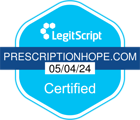Turning 26: Navigating Prescription Access After Losing Parental Insurance
Posted by Mathew Hickey - See Editorial Guidelines (Last Updated On: Tue Feb 13 2024)

As young adults reach the milestone age of 26, many are faced with the harsh reality of losing their parental insurance coverage. While this may seem like a small inconvenience, it can have a major impact on their health and finances. One of the biggest challenges that comes with this transition is the difficulty in accessing affordable prescriptions. Without employer-sponsored coverage, young adults may struggle to afford necessary medications. If you have just turned 26, Prescription Hope might be a good fit for you.
The Impact of Turning 26: Unveiling the Health Insurance Gap
Young adults often don’t give much thought to our health insurance until the moment it’s taken away. Turning 26 is a milestone that brings with it a harsh reality: the loss of parental insurance coverage. Suddenly, we’re thrust into a world where we’re responsible for finding and paying for our own health insurance. This can have a major impact on our health and finances.
Losing insurance coverage at this age creates the “health insurance gap.” It’s a period where we may be without coverage until we can secure our own plan. During this gap, we are left vulnerable and exposed to potentially high medical costs. Even routine check-ups or prescription medications can become unaffordable.
The impact of this gap goes beyond just the financial burden. It can lead to delayed or skipped medical care, as we try to ration our limited resources. This can have dire consequences for our health, as early detection and prevention are key to maintaining a healthy lifestyle.
In addition, the stress and uncertainty of navigating the health insurance landscape can take a toll on our mental well-being. We may find ourselves feeling overwhelmed and anxious, unsure of where to turn for assistance.
In the following sections, we will delve into the burden of prescription drugs without insurance and explore practical solutions for accessing affordable medications. Stay tuned as we uncover strategies to mitigate health and financial risks post-insurance loss and discuss legislative measures aimed at improving youth healthcare coverage. Together, we can navigate this new stage of life and ensure access to the affordable prescriptions we need.

The Burden of Prescription Drugs Without Insurance
The burden of prescription drugs without insurance is a daunting reality that many young adults face after losing their parental coverage. Without the safety net of insurance, the cost of medications can skyrocket, leaving young adults struggling to afford the treatments they need.
Prescription drug prices continue to rise, making it increasingly difficult for individuals without insurance to access the medications they require. Many young adults find themselves in a situation where they have to choose between paying for their prescriptions or other necessities, such as rent or groceries. This can lead to choices, like waiting on healthcare, that can have serious consequences for their health.
In addition to the financial strain, the burden of prescription drugs without insurance can also impact a young adult’s overall well-being. The stress of not being able to afford necessary medications can cause anxiety and emotional distress. It can be overwhelming to navigate the complex healthcare system and try to find alternative solutions for affordable prescriptions.
Furthermore, the lack of insurance coverage may result in delayed or inadequate treatment. Individuals may experience worsened symptoms or even develop complications that could have been prevented if they do not have access to necessary medications.
Possible Solutions for Affordable Medication Access
Now that we’ve explored the challenges of accessing affordable medications without insurance, it’s time to delve into possible solutions. While it may seem daunting, there are resources available to help young adults bridge the gap and ensure they have access to the prescriptions they need.
One option is to explore prescription assistance programs. These programs are designed to provide discounted medications to individuals who meet certain income requirements. They often partner with pharmaceutical companies to offer these discounts, making it more affordable for individuals without insurance. It’s important to research and apply for these programs as early as possible to ensure a smooth transition in accessing medications. Prescription Hope is one such program, offering access to these medications for just $60.00 per med per month through their medication access service.
Another solution is to explore alternative pharmacy options. Many pharmacies offer generic versions of medications at a lower cost than brand-name drugs. Additionally, some pharmacies may offer discount programs or coupons that can help reduce out-of-pocket costs. It’s worth reaching out to different pharmacies in your area and comparing prices to find the most affordable option.
For those who are eligible, government assistance programs such as Medicaid or Medicare can provide coverage for prescription medications. It’s important to check if you meet the eligibility requirements and explore these options to ensure you have the necessary coverage.
Lastly, it’s worth having a conversation with your healthcare provider about your financial situation. They may be able to provide samples or suggest alternative treatments that are more affordable. It’s always important to advocate for yourself and communicate openly about your financial constraints.
Remember, navigating the world of healthcare without insurance can be challenging, but there are resources available to help. By exploring prescription assistance programs, alternative pharmacy options, government assistance programs, and having open communication with healthcare providers, young adults can take steps toward accessing the affordable medications they need to maintain their health and well-being.

Strategies to Mitigate Health and Financial Risks Post-Insurance Loss
Although losing insurance coverage at the age of 26 can feel like stepping into the unknown, there are strategies that young adults can employ to mitigate the health and financial risks associated with this transition. Here are six key strategies to consider:
1. Explore your options:
Take the time to research and understand the different healthcare plans available to you. Compare costs, coverage, and benefits to find the plan that best suits your needs and budget. Don’t hesitate to reach out to insurance providers or use online resources to get a clear picture of what is available to you.
2. Consider joining a group plan:
If you are employed, find out if your employer offers health insurance benefits. Many companies provide group plans that can be more affordable than individual plans. Take advantage of this opportunity to ensure that you have adequate coverage.
3. Budget for healthcare expenses:
Losing insurance coverage means taking on the responsibility of paying for healthcare out-of-pocket. Set aside a portion of your monthly budget specifically for healthcare expenses. This way, you can be prepared for any unexpected medical costs that may arise.
4. Seek out community resources:
Many communities offer free or low-cost healthcare clinics, which can be a valuable resource for individuals without insurance. These clinics often provide essential services, including check-ups, vaccinations, and basic prescriptions.
5. Prioritize preventative care:
Without insurance coverage, it’s important to prioritize preventive care to avoid more expensive treatments down the line. Schedule regular check-ups, screenings, and vaccinations to maintain your overall health and catch any potential issues early on.
6. Utilize Prescription Hope:
Prescription Hope can help you bridge the gap in your prescriptions. For each med, you only pay $60.00 per month and have over 1,500 prescriptions to choose from through their medication access service.
Remember, losing parental insurance coverage at 26 can be a challenging experience, but by taking the initiative and utilizing available resources, you can mitigate the health and financial risks associated with this transition. Stay informed, advocate for yourself, and prioritize your health to ensure a smooth and healthy journey into adulthood after losing parental insurance coverage.
Looking Ahead: Legislative Measures to Improve Youth Healthcare Coverage
Looking ahead, it is important to consider the potential impact of legislative measures aimed at improving youth healthcare coverage. As young adults navigate the challenges of losing parental insurance coverage, they must have access to affordable and comprehensive healthcare options. Legislative measures can ensure that this transitional period does not leave young adults vulnerable.
One possible legislative measure is the extension of parental insurance coverage for young adults beyond the age of 26. By allowing individuals to remain on their parent’s insurance plans for a longer period, they can have more time to establish their coverage and avoid gaps in insurance.
Another measure is the expansion of Medicaid eligibility to include young adults without insurance coverage. Medicaid provides affordable healthcare options for low-income individuals and expanding the program to include more young adults can help bridge the coverage gap and ensure that they have access to necessary medications.
Furthermore, implementing regulations to control the rising costs of prescription drugs can significantly alleviate the burden on young adults. Promoting transparency in pricing and encouraging competition among pharmaceutical companies can reduce the cost of medications, making them more affordable for all individuals, regardless of insurance coverage.
In addition to these measures, lawmakers need to prioritize the overall improvement of healthcare coverage for young adults. This includes promoting comprehensive healthcare plans that cover essential services, preventive care, and prescription medications.
By focusing on legislative measures aimed at improving youth healthcare coverage, we can work towards a future where young adults have access to affordable and comprehensive healthcare options. Lawmakers must ensure that they do not leave young adults vulnerable during this pivotal stage of their lives by prioritizing their health and well-being. Together, we can advocate for change and create a healthcare system that supports the needs of young adults.


